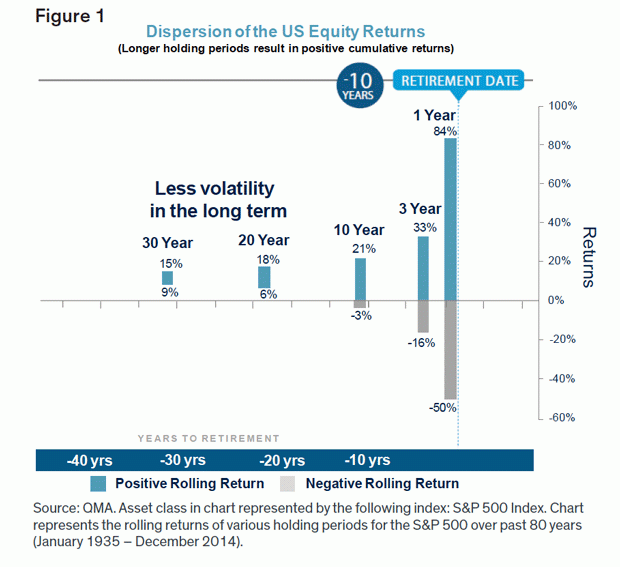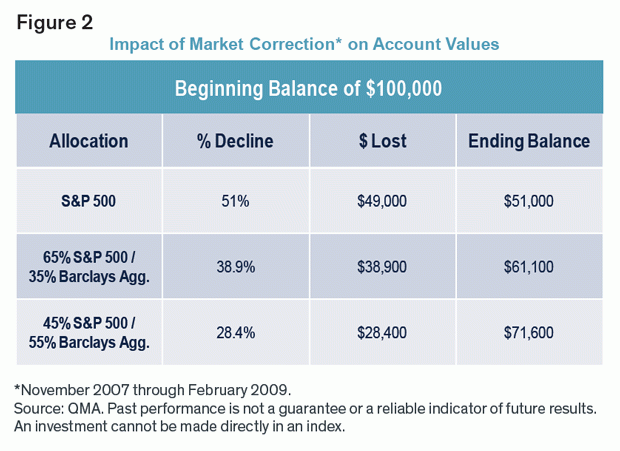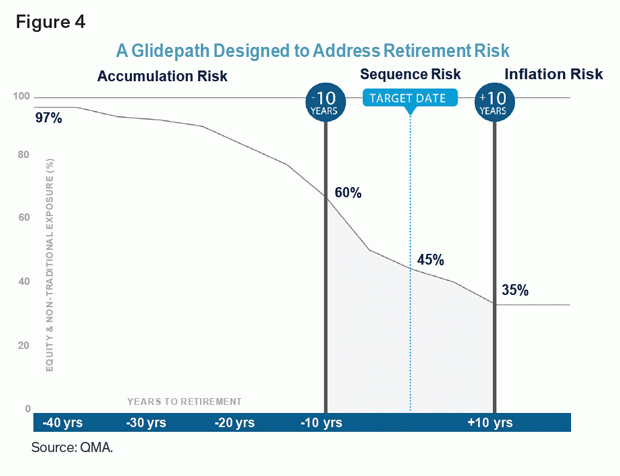The challenge: Many employees fear they might fall short of reaching a sufficient amount of savings to provide a source of sustainable income throughout retirement. This anxiety is exacerbated by the “longevity risk” of longer lifetimes that may require saving for up to 30 years, or more, of retirement. Plan sponsors are responding by seeking to deliver outcome-oriented retirement solutions that may provide for participants well beyond their first day of retirement.
Prudential’s Day One Funds are designed with these challenges in mind and are based on extensive research and analysis of participants in defined contribution plans serviced by Prudential Retirement. The findings from this research helped us form a better understanding of the primary risks participants face at different stages of their retirement planning—accumulation risk, sequence of returns risk, and inflation risk. Any of which could potentially lead to a shortfall in retirement assets. In addition, because high investment costs can also undermine retirement goals, we’ve combined active and passive vehicles—which may help to achieve risk-adjusted returns while maintaining cost effectiveness.
Accumulation Risk—Being too cautious early on
Younger employees with lower balances and longer time horizons need to save more and generally have a long time horizon until retirement to invest. Therefore, exposure to equities and other assets which may provide higher returns early in an investor’s career can be critical. As seen in Figure 1, in the short run, equity returns can be volatile. However, when investors are able to take a longer investment outlook that short run volatility fades. Thus, longer holding periods afford younger participants the time to benefit from the potential positive cumulative returns from higher returning assets.

Sequence of Return Risk—Poor returns at the worst possible time
Significant losses in the few years leading up to and just after retirement can lead to inadequate savings. To mitigate this sequence of returns risk, we significantly reduce equity exposure during the 10 years before and after retirement—the “Retirement Red Zone®”— by reducing exposure to equities and increasing exposure to fixed income. We believe this is critical at a time when participants have less time to recover from a hard hit to their retirement portfolio. During the 2008/2009 market correction for example (Figure 2), reducing equity risk could have preserved a significant percentage of wealth for those participants in or approaching retirement.

Inflation Risk—The loss of purchasing power
Despite the absence of broad-based inflationary pressures in recent years, inflation likely will rise at some point. Even low inflation compounds over time and can significantly erode purchasing power. As illustrated in Figure 3, we believe the best way to maintain a post inflation standard of living in retirement is through diversification employing a blended portfolio with multiple assets with low correlations, such as commodities, private real estate, REITs, and TIPS.
Our Research Shaped Glidepath
Taking an institutional asset/liability approach and drawing from years of experience developing sophisticated asset allocation strategies, our research-shaped glidepath is designed (Figure 4) to address these three primary risks over a participant’s lifetime. The Day One Funds do this by investing more aggressively early on when participants have the longest time horizons. Our maximum allocation of 97% to domestic and foreign equities, commodities and real estate is one of the highest in the industry, and represents our conviction that accumulation risk is best addressed early on by (i) saving more, and by (ii) investing in asset classes that may provide higher returns over the long-term.
Ten years before retirement, our glidepath begins to focus on “sequence of returns risk” and takes a more aggressive move away from riskier assets than many other target date funds. We strongly believe that positioning the portfolio in such a deliberate manner outweighs the benefits potentially achieved from chasing higher returns when investment horizons are waning.
And finally, our glidepath is designed to mitigate inflation risk during the drawdown phase of a three decade retirement. Our blend of equities, fixed income, and non-traditional assets is designed to provide a greater ability to preserve purchasing power from inflationary shocks than a higher equity portfolio post retirement.

Author: Jeremy Stempien, Product Specialist, QMA’s Asset Allocation Investment Team
Time horizons and risk
Millenials, those born between 1980 and 1999, on average are saving only about 8%1 of their income and more than 40% are not saving for retirement at all. What’s more, many might be investing too conservatively, with large cash and bond positions. When compared with people in their 20s in 1998 (15 years earlier), Millenials have approximately half the equity exposure.2 The “accumulation risk” as a result may lead to a wealth shortfall decades down the road. To mitigatethis risk, younger workers should not only consider saving more, but also take advantage of their longer investment horizons and potentially gain from the higher expected returns of equities and other assets with greater upside potential.
Generation X, born between 1960 and 1980, is saving more, approximately 12% on average towards retirement. Many among them still have fairly long time horizons and may be approaching or are in their peak earning years. Consistent retirement saving as well as exposing those assets to market risk is critical for them to avoid a potential accumulation shortfall. For the older members of this group, shortening time horizons means that a reduction in riskier retirement assets makes sense.
Baby Boomers, born just after WWII until 1960, are saving the most, approximately 14% on average for those not already in retirement. However, younger boomers in the last decade of their careers need to be focused on the sequence of return risk by reducing risk significantly before entering retirement. This is the time to protect the retirement assets they have accumulated by reducing equity market exposure in the years before retirement. For Boomers already at and in retirement, inflation risk should be the primary focus and may be addressed through an appropriate asset mix designed to mitigate the erosion of purchasing power.
1 Prudential, “Financial Literacy and Retirement Preparedness Study,” 2014.
2 Employee Benefit Research Institute, “401(k) Plan Asset Allocation, Account Balances, and Loan Activity.” Reports 1999-2014 shows that investors in their 20s invested 31.9% in equities in 2013 compared to 62.1% in 1998.




